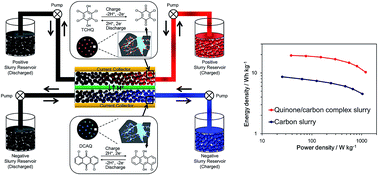High-energy-density electrochemical flow capacitors containing quinone derivatives impregnated in nanoporous carbon beads†
Abstract
Electrochemical flow capacitors (EFCs) are promising energy storage devices for smart grids due to their combination of the high power capabilities of electrochemical capacitors and the scalability of redox flow batteries. However, the limited energy densities of EFCs are their drawback. In this study, we demonstrate a promising approach to capacitance enhancement in EFCs, based on the impregnation of redox-active quinone derivatives in nanoporous carbon for flowable slurry electrolytes. Moreover, we employed two different quinone derivatives with different redox potentials as anodic and cathodic electrolytes, facilitating a proton-shuttle mechanism. The resulting slurry electrolytes exhibited good flowability, high power capability and an energy density of approximately 20 W h kg−1, 2.5 times higher than that of the unmodified carbon slurry. Charge–discharge measurements in an intermittent flow system confirmed that the modified slurry electrolytes were suitable for use in EFC systems. This approach, based on the use of solid-state redox-active organics, should allow extraordinary capacitance enhancement in flow-type energy storage systems such as redox flow batteries and EFCs.



 Please wait while we load your content...
Please wait while we load your content...